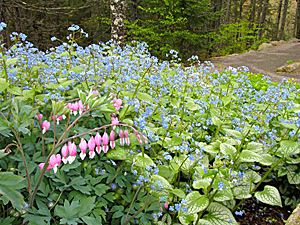 This classic combination of bleeding heart with Siberian bugloss is a beautiful late spring duo for a shady spot in the garden. The intense blue flowers of bugloss are the perfect accompaniment to bleeding heart’s rosy pink flowers. The heart shape of bugloss’s leaves echo the shape of bleeding heart’s flowers while contrast is provided by the differences in the texture of the leaves. Bleeding heart has deeply divided blue-green leaves that give a lacy texture in contrast to the large coarse leaves of bugloss. Both plants do well in part shade, and consistently moist, well-drained soil.
This classic combination of bleeding heart with Siberian bugloss is a beautiful late spring duo for a shady spot in the garden. The intense blue flowers of bugloss are the perfect accompaniment to bleeding heart’s rosy pink flowers. The heart shape of bugloss’s leaves echo the shape of bleeding heart’s flowers while contrast is provided by the differences in the texture of the leaves. Bleeding heart has deeply divided blue-green leaves that give a lacy texture in contrast to the large coarse leaves of bugloss. Both plants do well in part shade, and consistently moist, well-drained soil.
 Bleeding Heart (Dicentra spectabilis)
Bleeding Heart (Dicentra spectabilis)
There are few flowers that evoke a more romantic image than bleeding heart. Everything about the above ground plant is graceful and beautiful from the long, arching stems bearing the nodding flowers, to the flowers themselves. Each flower consisting of two kinds of petals, outer pink ones and inner white ones that protrude as the flowers develop. The foliage is very attractive but unfortunately usually dies down by mid-summer as the plant goes dormant. For this reason hostas, ferns, or cranesbills are frequently planted with them to fill in the space left as the bleeding heart disappears.
Bloom Time:
-
- Mid- to late spring
Size:
-
- 24-30 H x 24-30 W
Hardiness:
- Zones 3-9
 Siberian Bugloss (Brunnera macrophylla)
Siberian Bugloss (Brunnera macrophylla)
With sky-blue flowers like those of forget-me-nots in both color and form, Siberian bugloss is an easy to grow favorite perennial for woodland gardens. It forms sturdy clumps of coarse heart-shaped leaves in early spring and sends up flowering stalks that bear clusters of small blue flowers with yellow eyes. The dark green foliage remains attractive all growing season. Several cultivars are available such as ‘Jack Frost’ that have especially attractive leaves and provide long-season interest.
Bloom Time:
-
- Mid- to late spring
Size:
-
- 12-18” H x 18-30” W
Hardiness:
- Zones 3-9
